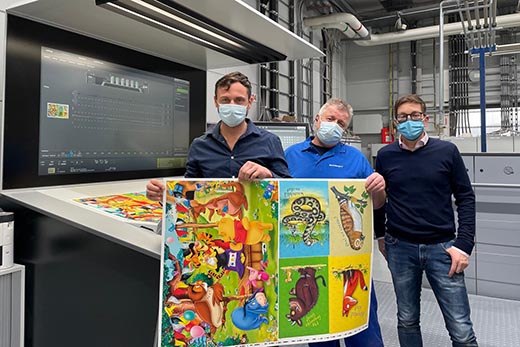International Toymaker Ravensburger Uses Speedmaster Technology from Heidelberg
Highly automated Speedmaster XL 106-5+L with Plate to Gallery and pallet logistics


From left to right: Markus Deient, Hans Geist, and Stephan Lehmann in front of the Prinect Press Center XL 3, the sheetfed offset system’s control station.
- Push to Stop concept for autonomous job processing
- Press delivers on performance promise in extensive tests
Ravensburger AG is one of the world’s leading producers of board and card games, toys, jigsaw puzzles, and children’s books. Boasting both German and international brands such as Brio, Think-Fun, and Wonder-Forge, the company employs over 2,300 staff worldwide. Most of its products are developed and manufactured in-house.
The demand for jigsaws and games is currently exhibiting strong growth. This is demonstrated, among other things, by Ravensburger’s in-house print volume, which has increased significantly in recent years. The company’s Head of Production, Tobias Liebing, has the figures to prove it: “In the space of three years, the number of sheets printed at Ravensburger has risen from 37 million to 49 million.”
A highly automated printing system
Sheetfed offset printing is used in the competence center for print production at the company’s site in Ravensburg. Paper grades, formats, and the ink sequence are largely standardized. A Speedmaster XL 106-5+L from Heidelberger Druckmaschinen AG (Heidelberg) – a five-color system with coating unit – was taken into operation in summer 2021. An extended sheet format of 76 x 106 centimeters (standard format: 75 x 106 centimeters) means utilization of the printable sheet area can be optimized when producing multiple-ups.
The Speedmaster XL 106 is a highly automated system from the 2020 generation with a Push to Stop configuration. Jobs that are added to the job queue are therefore completed automatically. The Intellistart 3 assistance software analyzes the jobs in the list and determines independently which makeready sequences to activate during a job change. The Speedmaster Operating System guides print engineers through the production process, indicating when manual intervention is required.
Plate to Gallery for faster printing plate logistics
Plate to Gallery is an automated plate logistics solution that lifts the printing plates to gallery level on the press. Thanks to AutoPlate Pro, it takes little more than two minutes to change an entire set of plates fully automatically in all five printing units. The Prinect Inpress Control fully automatic color measuring system adjusts the ink feed and register within around one hundred sheets, while the Quality Assistant system monitors all quality parameters. As soon as the target values are achieved, Intellistart 3 automatically switches to production speed.
To maximize net outputs, the press stands on a foundation elevated by 525 millimeters. The delivery supports non-stop production, with an underfloor conveyor system automatically supplying the empty pallets as each pile is removed. In the delivery pile, InsertStar separates the individual jobs (by automatically inserting tapes).
Liebing considers process automation to be extremely important. “With four or five job changes an hour, the speed of makeready processes determines how cost-effective production is,” he explains.
Sheetfed offset press availability of 99.4 percent
Ravensburger carried out an extensive test run before taking the decision to invest in a sheetfed offset press from Heidelberg. The Speedmaster XL 106 in the Heidelberg demonstration center at the Wiesloch-Walldorf site had to prove how efficiently it could produce the customer’s print jobs using the same consumables as in Ravensburg. “The high demands we placed on the technology in terms of paper waste and net output were met in full,” confirms Liebing, who is particularly impressed by how reliably the press runs, even with relatively thin printing materials.
The outstanding results of the test run were borne out in practice. Six months on from commissioning, Liebing reports the technical availability of the press is 99.4 percent. “This printing system has well and truly won us over,” he says.
Automatic compensation of paper distortion
Besides cardboard, much of Ravensburger’s work also involves standard paper grades. Paper of this kind is prone to distortion during the printing process, which can lead to register inaccuracies from printing unit to printing unit. This can be counteracted using Prinect Automatic Paper Stretch Compensation. The level of distortion can be predicted for each specific paper grade, and the software compensates for this during plate imaging.
Prinect Automatic Paper Stretch Compensation is particularly effective when printing motif sheets with fine hairlines, and also when a large number of repeats are spread across the sheet. “The software from Heidelberg contributes to quality standards and is a tool we no longer want to do without when it comes to meeting our high requirements,” insists Liebing.
Customer relationship based on trust and partnership
“Convincing a company like Ravensburger of the benefits of Speedmaster XL 106 technology once again demonstrates the competitiveness of our Push to Stop concept,” says Dr. David Schmedding, Managing Director of Heidelberger Druckmaschinen Vertrieb Deutschland GmbH. “Our long-standing customer relationship with Ravensburger is based on trust and partnership. The company knows it can always rely on the Heidelberg team and our expertise,” adds Mirco Klumpp, who is responsible for sales and customer service.
